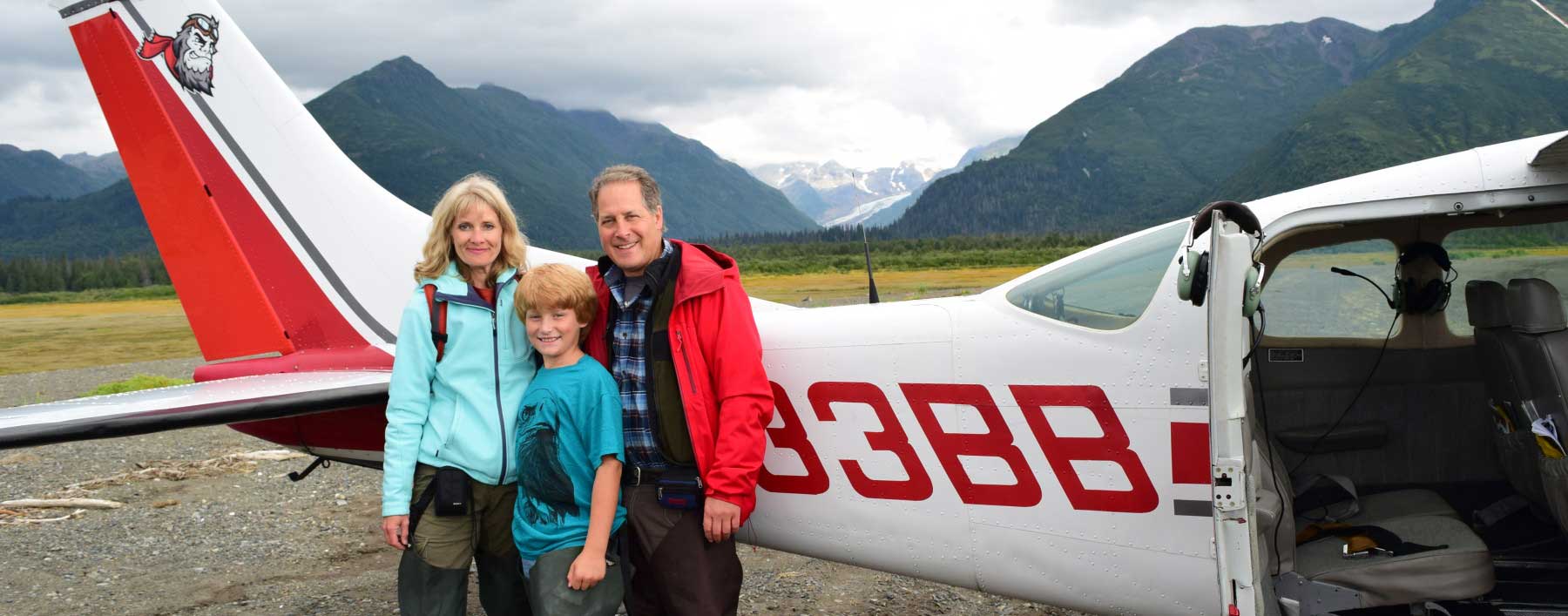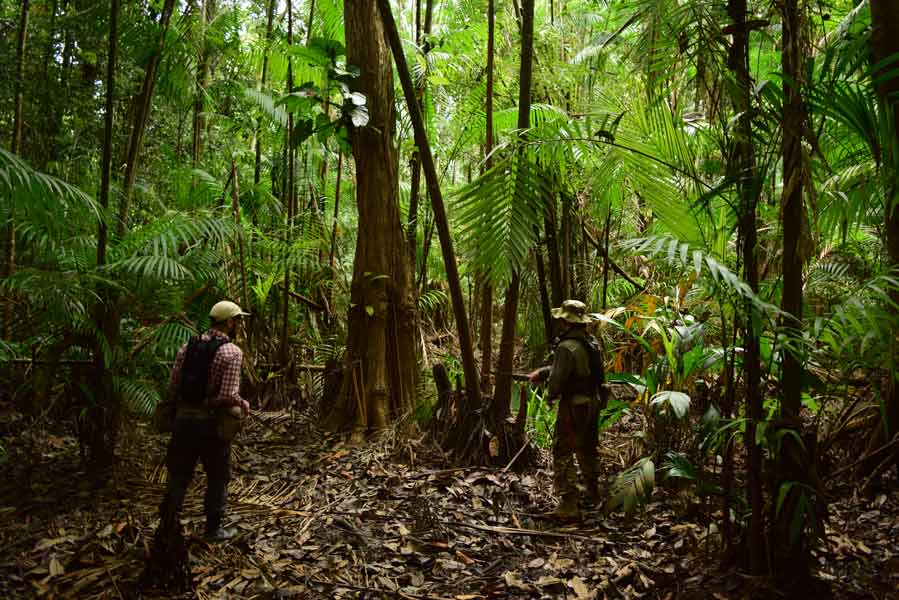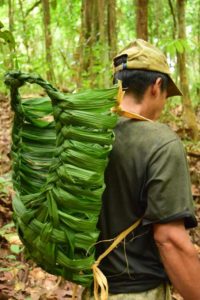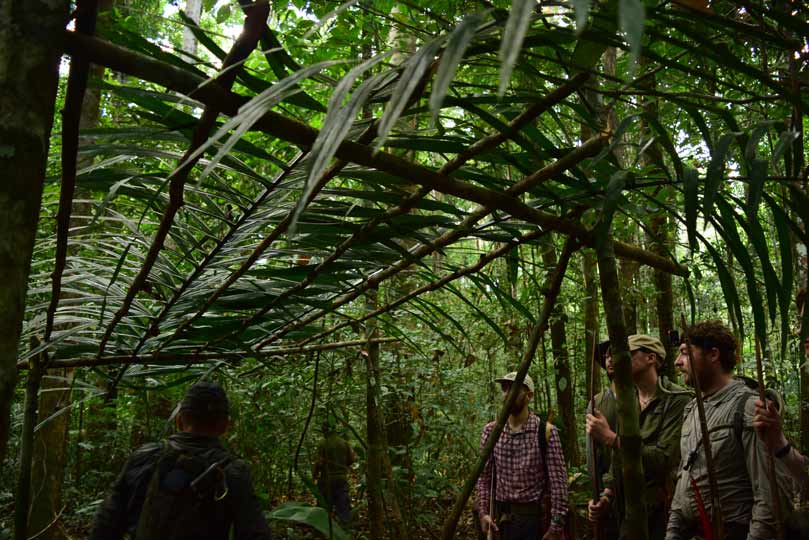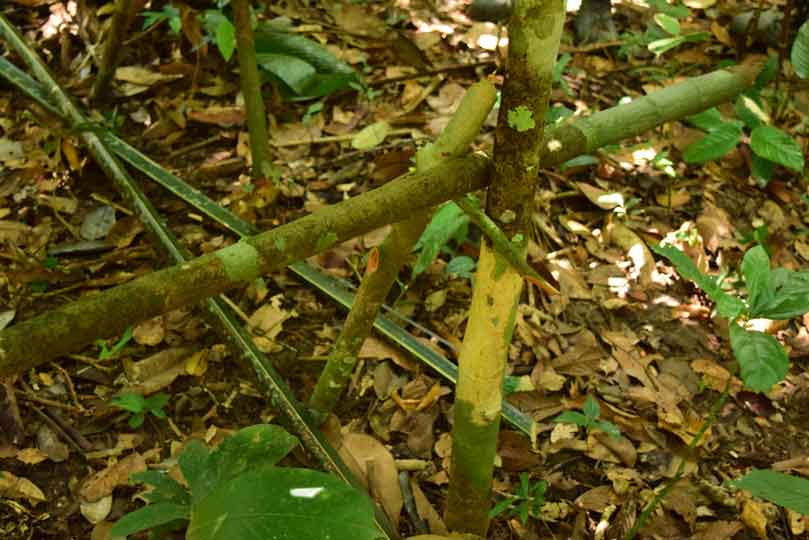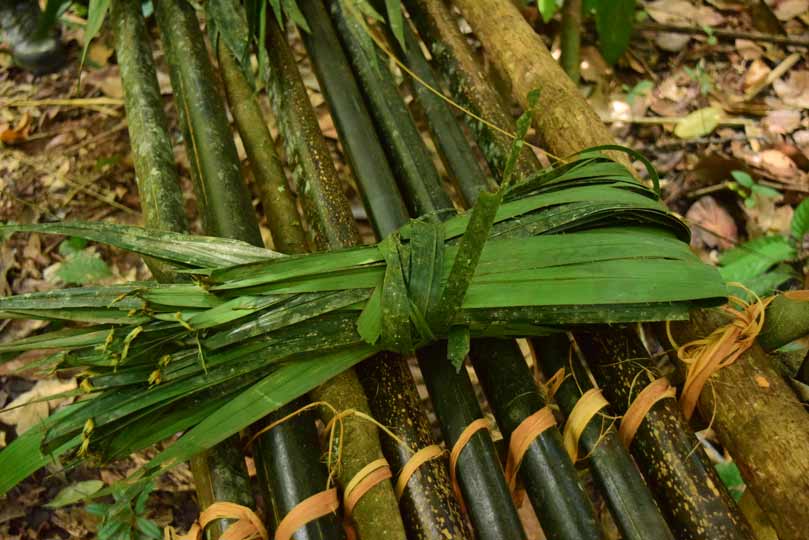Our last day here, before we go into isolation! After breakfast, we get into the boats. After a short boat ride, we get out and walk. And walk. And walk.
This seems a bit less focused than the last walkabout, or maybe it just seems long because it’s hot and I’m impatient to learn shelter building. Eventually, we come to a grove of palm trees: heart of palm! Lionel and Ian pick out one tree to bring down.
The heart of palm is located at the top of the tree, right underneath where the palm fronds come out, because it is the food sustaining the newly forming frond. As you pick a tree to harvest, make sure there is a clear line for it to fall; the last thing you want is to hack through a tree trunk and have the tree fall…into some other trees, where you cannot reach it! Ian tells us to remember to work with gravity: the majority of trees naturally lean one way and that is the way they want to fall. “Work with gravity. Gravity always wins!”
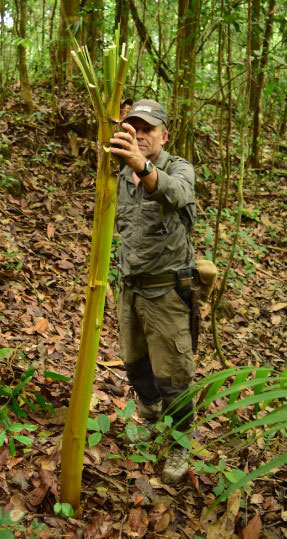 B volunteers to take the tree down and he chops it down pretty quickly. It’s a long ass tree! Someone else cuts off the top, one cut at the first leaves and one about 5 feet below that.
B volunteers to take the tree down and he chops it down pretty quickly. It’s a long ass tree! Someone else cuts off the top, one cut at the first leaves and one about 5 feet below that.
Lionel shaves that section, peeling back more and more of the outer layers. Eventually he gets to the heart of palm: the piece is maybe 8 inches long and two fingers wide in diameter, like the inside white portion of a leek.
Ian passes it around, so we can all take a bite. Tastes good, but it seems like a lot of work for so little food! 1000g (about 2 pounds) have 1000 calories, which is great, but what we got from this tree was maybe 200g, maybe 7 oz.
The energy I would use up to chop down 5 trees is enormous, surely more than 1,000 calories. Still, if you really need food, this is the only guaranteed food available 24/7.
Next, Derrick shows us how to weave a backpack out of one palm frond, cut in half (“if you’re transporting fish, you don’t want to do that in your regular rucksack: it’ll stink and you’ll have ants all over it!”). I had watched a bunch of Youtube videos on weaving/braiding with palm leaves before coming out, and thought I had some of the techniques down, but he does it so fast, I can barely follow with my eyes, let alone my brain.
He weaves the two parts together for the back, then somehow gathers and bends the front to make the bottom, then the front lip, then the sides and a handle.
He gets Stevie Wonder bark and ties back straps on and it’s now a full-fledged backpack. Ian asks who wants to try making one. Nobody else says anything, so I volunteer.
Takes me quite a bit longer, and I need guidance all along, but eventually, my backpack looks pretty close to his!
 Ian puts one of the packs on his head and now looks like Grand Moff Craddock. All hail the great leader, LOL!
Ian puts one of the packs on his head and now looks like Grand Moff Craddock. All hail the great leader, LOL!
We move on and our next stop is shelter building. Finally! This is the activity I have most been looking forward to since it’s probably what I’ll be spending most of my time on in isolation.
Ian gives us the head shake: “on these reality shows, the ‘experts’ spend three days building a shelter. It takes the guys half an hour, you’ll see!” And it does. 26 minutes, to be exact.
Of course, that’s Lionel and Derrick working together, chopping trees. Figure that times 5x for the normal person and times 10x for me, with lesser machete skills (yes, yes, “it’s not about strength; it’s about technique!”).
The 26-minute jungle shelter
The first thing is siting the shelter. Your highest priority is water, so you want to be close to the river.
The river also fulfills two other priorities: rescue and food. (“Any rescuer in the jungle is going to fly over the canopy and follow the rivers, navigable rivers, not a little creek coming off a mountainside – follow the creek down to a navigable river!”).
As a frame for the shelter, you are looking for 4 trees in a square or rectangle, about 2m away from each other, or 6 or 7 feet. They don’t have to be huge, maybe upper arm size, or so. Of course, you may not find 4 trees situated exactly right, but usually, you can find at least 3, and you chop off a tree and sharpen the bottom and ram it into the dirt to make the fourth post (well, during rainy season anyway; what to do during dry season when the ground is rock hard, I have no idea). Oh yeah, the same cautions about deadfall and leaning trees apply here as to tying a hammock. And of course, you need to check for killer bee nests, bullet ants, the works.
 So, once you have your four trees, or three and a post (if you can’t find three, find another site!), the idea is to build two frames around them: one for the roof, and one (three sided), for the bench/bed.
So, once you have your four trees, or three and a post (if you can’t find three, find another site!), the idea is to build two frames around them: one for the roof, and one (three sided), for the bench/bed.
Next, you cut 4 trees that each have a Y-fork at about 8 feet up (“smart people look at the tree before they start chopping and pick a tree that they can get 2 poles out of, not just one”). Situate two Y fork trees on the INSIDE of the shelter posts and lay another pole that’s a little more than the width of the shelter over them, wedging the pole into the Y forks, against the shelter posts.
You do that on all 4 sides, twisting the Y-forks if necessary, pulling them out to lean against the shelter posts to make it all work. Ideally, one side of the shelter has poles a little higher than the opposite side: for a slightly slanted roof (more slanted during rainy season, less slanted during dry season); you want to give the rain an easy way to run off. Add a few thin poles across the roof, to serve as rafters, to hold up the palm fronds that will be used for the roof thatch.
Kukrit palm fronds used as thatch: “Use it like Nature made it: the side that’s up in Nature, should be up on your roof.” Once you have a thick layer of palm fronds on the roof, tuck the straggly bits of leaves up into the thatch, or you will get drips from them.
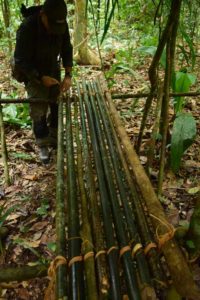
Next, you use the same principles to build the lower frame, at maybe 2 or 3 feet off the ground, but only 3 sides need to be completed and poles Y-forked: the fourth side is going to stay open and be the entrance into the shelter. On the side opposite the entrance, you will create a bench/bed by adding more poles parallel to the outside frame.
Depending on the materials you have at hand, they can be wood (thin trees, maybe an inch in diameter, as straight as possible and with no knots or broken off branches that will stab you in the butt in the middle of the 12 hour night), or, better, you can use kukrit fronds, from the teenage kukrit palm tree.
The actual leafy part of the fronds will be used as thatch for the roof; the stalks make a great mattress, strong but flexible, AND smooth (well, after you cut off the sharp edges of the triangular stalk with your machete: just nick them in the center of the sharp edge and then peel off the edge).
Depending on how big you are and whether you’re a back sleeper or side sleeper, you make the mattress/bench narrow or wider. 8-10 poles/stalks seem good to me. Use Stevie Wonder bark to lash the poles to the frame underneath and to each other, so they don’t move during the night, when you can’t see to fix anything.
Fi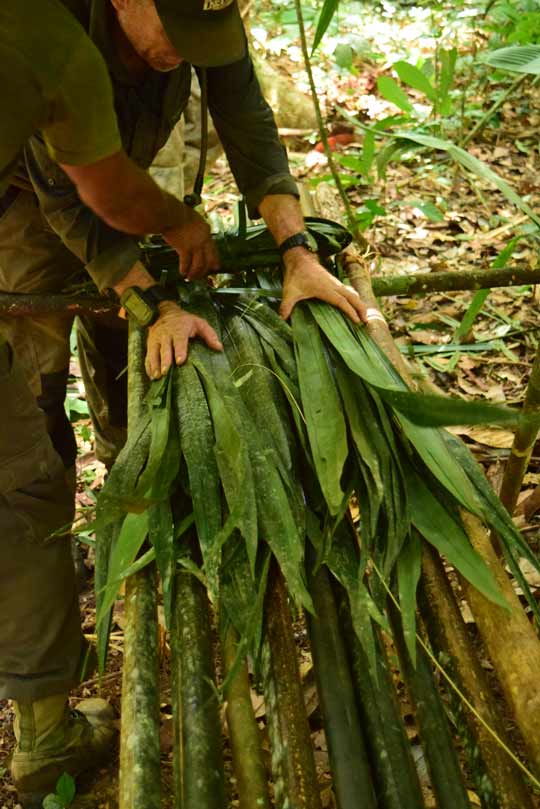 nish up by gathering palm leaves and bunching them up for a pillow, and piling lots more onto the poles for a softer bed: “make your shelter as comfortable as possible! You’ll be spending a lot of time in it. These nights are fucking loooong!” (Of course, you’ll have a fire to entertain you: “Neanderthal TV!” but you’ll still be spending a lot of time on that bench!)
nish up by gathering palm leaves and bunching them up for a pillow, and piling lots more onto the poles for a softer bed: “make your shelter as comfortable as possible! You’ll be spending a lot of time in it. These nights are fucking loooong!” (Of course, you’ll have a fire to entertain you: “Neanderthal TV!” but you’ll still be spending a lot of time on that bench!)
We divide into two groups and each team gets to build their own shelter. I chicken out of the tree chopping. — Yes, I should practice more, but I am telling myself I might as well save blistering my hand for tomorrow when I have to do this for real; and I’m slow, and I’m not sure I want everyone else to see just how slow and painful my chopping is. Lots of excuses.
I cut and drag a few thinner trees over that can be used for rafters, then look for Stevie Wonder trees, so we can get bark. I find a few that I think are Stevie Wonder and nick the bark. The inner layer doesn’t really peel. So, either I’m doing it wrong or it’s not the right tree.
In the end, three of us are looking for bark trees, all unsuccessfully. Derrick comes over and basically laughs at us when we tell him we can’t find a tree (somehow they always laugh: every time I ask, they are graciously offering help, but they can’t really suppress a smile – I must seem like the greatest dufus out there, but hey, at least I’m trying, and if I don’t ask, I don’t learn!). He peels bark for us on a tree that was right in front of us, and we use it to lash our bed poles. The shelter looks nice! Ian and the other team come later to inspect it and it passes. Whoohoo! (now, if I can only remember how this was all put together, for building my own tomorrow! Later this afternoon, I will have to study the photos I took during the construction, so I can remember.)
On the way back to the boats, we bushwhack through more jungle. If it wasn’t for Lionel and Derrick guiding us, both of whom have some sort of innate sense for where they are and where they’re going, I’d say we were lost. Uphill, downhill, through vines, over logs, we do the message relay Ian taught us: “wait for the person behind you to come close and then repeat EXACTLY what I told you, in my words, don’t use your own!” So we keep walking: “Tapir tracks on the left!”– “Watch for the spiky vine here!”– “Set a trap just outside this hollow log because it might have an animal living in it!”
Log “bridge” river crossing
Finally, we get to the river. Correction, not THE river, A river. And we have to cross it on a log. A big, round, long log, which, two thirds across the river, twists up, so you need to do a little climb up before you get to the other side.
Fuck. I swear under my breath. I don’t need this. Yes, the whole crossing the river on a log thing is cool. But can I just watch the other guys do it and take pictures? I’d actually be ok with crossing the log barefoot, if it wasn’t for scorpions and ants and such. I can do pretty much anything barefoot, but in hiking boots slippery with mud? Tried that a few days ago, didn’t work so well – my boots are dry, thank you very much, and I’d like to keep it that way for iso.
And I have my big Nikon to protect (camera around my neck, big lens in a waterproof-ish bag over my shoulder, banging the camelbak with every step, and the belt kit).
And I’m carrying my 5-foot long bow and arrows. And my yariyari rod. AND the palm frond backpack. It was hard enough dragging it all through the underbrush, getting the bow string stuck on vines, stabbing the arrows through the backpack occasionally. Now I’m supposed to balance bow and arrows and fishing rod on the left, jungle backpack on the right, camera around my neck and not fall in?
Rationally I know it’s not the end of the world to get wet (yes, think of the hilarious Youtube video that someone will take: what happens in the jungle is on Youtube just as soon as you have a signal!), but that doesn’t mitigate the wave of panic that washes over me. I tell myself, it’s not happy camping, it’s survival. But the voice comes back and says, bullshit. This has nothing to do with survival, it’s purely macho bravado and I so don’t want to embarrass myself.
But what choice do I have? I need to just pull myself together and do it. And if I have to crawl, fine. I’m watching one of the guys cross, with just a little hesitation on the climb, then he’s across. Another is crossing slowly, slowly and Ian mutters under his breath that slowing down is the kiss of death. You need to keep momentum. Then the guy crouches down, and finally belly crawls up the incline. I guess that is what I will have to do.
Derrick, in the meantime, has scouted further down the river to see if there is another way to cross. One of the guys goes and checks it out and reports back that the other log crossing is also challenging, but at least level and that he’s going to cross there.
Well, I guess it doesn’t hurt to look at it. It’s just as long, an older tree, overgrown with vines and other shit, and partially rotted in the center. But level. The guy crosses in front of me and helpfully points out that there is a rotted away hole in the center, where you only have about half a foot width of space on the side where you can step, and no handholds to speak of.
Yeah! Sounds awesome. Let’s do this! With death defying determination, I grab my bow and arrows and start crossing (I have decided to abandon my backpack – not worth falling off the tree for! I guess I can always make myself a new one!). It’s ok until I get to the rotted center. Not much room to step, but I watched the guy in front of me and know where he stepped and how he held on.
I stop to shift my load and then tackle it. It’s fine. It’s the long stretch after the center rot that, all of a sudden, gives me pause. It’s wide, fairly dry, and should be no issue. Yet I hesitate. “Keep moving!” “You’re almost there!” I hear from the other side. Yes, I know. But the panic is here, right now. My battle. Ridiculous. I’m almost across and I’m hesitating?! Let’s fucking do this! I take a deep breath and finish the crossing.
Just as I finish the last steps, I hear a loud splash from the other direction. Sounds like someone took a spill! Thank God, I’m across! We walk back and catch up with the others and find out B fell in on the last stretch…and lost his GoPro in the process. That really sucks. I can so relate: getting soaked is bad enough, but to lose the camera that all your memories from the trip are on has to be devastating. He is still in the water and fishes around for a while and finally asks for a pole so he can poke around on the ground.
A few minutes later, an excited shout: he found it!! And it’s still recording! 15 minutes of murky underwater blub blub…and still going strong! B comes out sopping wet, but happy that he found the GoPro. He’s such a good sport about the whole thing. I know I wouldn’t have taken it so well.
After crossing another river by wading through it (this time I do take my boots and socks off and hang them around my neck), we are finally back at the boats. And ‘home’ shortly after.
STOP: what to do in the first 15 minutes
Admins make hot water and we get a short lecture on the first 15 minutes after a survival incident: Ian introduces us to the S-T-O-P principles that he wants us to remember and use tomorrow, then we have free time to get ourselves prepared for isolation.
S – STOP, SIT – if something happens, don’t run off like a chicken with its head cut off. Pause for a moment and …
T – THINK – what has happened, what are the consequences?
O – OBSERVE and organize yourself.
P – PLAN; follow the plan, but be flexible enough to adjust the plan if need be.
Ian tells the story of a survival expert who was with a group and just put down his belt kit to go pee. When he came back, the group was gone. In a panic (he didn’t Sit or Think), he ran after them but in the wrong direction. Didn’t find them. And got lost. Couldn’t find his belt kit anymore and was now lost in the jungle without any survival tools. What he should have done was stay with his belt kit and wait for the group to realize that he was lost and come back for him – eventually that is what happened: they found his belt kit, but not him! (He did survive, and now takes his belt kit EVERYWHERE.)
So, lesson for tomorrow: when you get dropped off, sit down and survey your surroundings before you do anything (“I can’t tell you how many blokes start chopping down trees the second we leave! We have barely turned the boat around and I hear the chop, chop chop!”).
We have the rest of the afternoon to get ready for tomorrow. We need to pack everything up and stash it away in our backpacks, and will only leave the tarp and ridgeline up. We will hang our backpacks from the ridgeline, off the ground (“if you make it through isolation, you will not see this land again!”). If someone taps out, they can re-set up their stuff; if we make it through, Ian and the guides will bring our backpacks in the boats when they pick us up.
We’re allowed to bring with us a small emergency kit with band-aids and stuff we’ve been using, like blister cream, hydrocortisone, whatever. I really haven’t been using anything, but pack stuff up anyway. A few of my malaria pills, and a few of the antibiotics left over from when I got bitten by our cat just before the trip: if I get a cut that gets infected, I don’t want to have to tap out because of that. And we’re allowed to take a phone/camera, so I decide to leave behind the big Nikon that’s fussy and makes me feel like a tourist, and just take the small Canon, and my phone for backup. And my voice recorder.
At the first camp, Ian gave us all a yellow dry bag and a radio for emergencies: if you twist the dial on the left, the phone turns on and emits a signal that Ian’s radio will pick up. He continuously monitors the frequency and all our radios have numbers, so he’ll know who is calling, and he’ll get come and get you out. Which also means, you cannot play with the radio, because if you activate it accidentally, you’re still out. So, he tells us to take the batteries out, just to be sure.
So, I have my belt kit, my orange dry bag for my camera, phone and recorder, and my photos of my family, (and the note my son wrote for me, that I haven’t read yet, to encourage me in case I’m close to quitting), my yellow bag with radio and emergency kit, and my bamboo cook pot. I don’t actually think I’m going to cook anything, but I’ll take whatever I can take. You never know.
Oh yeah, and of course I’m taking my bow, and arrows, and yariyari rod. I’m trying to figure out a way to put the 30 or so kukrit nuts I foraged for earlier, on our walkabout, in the belt kit. There’s space for maybe 5. Then I come up with a devious plan: I tell S that I’m thinking about emptying out my water bottle and filling it with kukrit nuts, just until we get to my dropoff site. Then I can take the nuts out and fill the bottle with water. He gives me a slightly bemused look and wonders out loud if I have experience as a mule for drug smugglers. LOL. No! I swear! I just like to eat! And that makes me inventive…Later on, Ian says I can just put the nuts in my pockets. I guess I’ll be going into iso like a squirrel: every pocket stuffed with nuts! Ultimately, S comes up with a better plan: he’s filling his bamboo cookpot with the nuts. Brilliant!
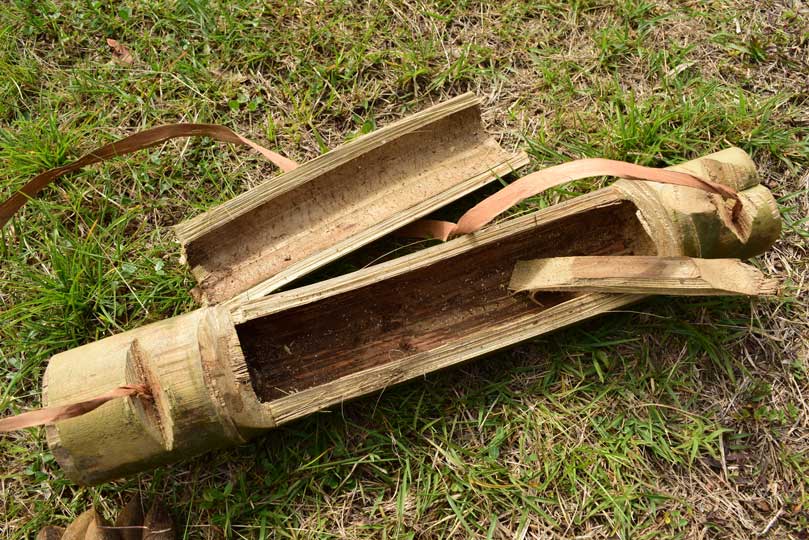
Dinner is a quiet affair. Everybody is sort of subdued and pensive. Ian says it’s always like that during “the last supper.” People try for half-hearted jokes and how-bad-can-it-be discussions, but the nervousness is palpable. Most people go to bed early. I hang around the fire for a while, but eventually turn in too.
Around midnight, I wake up: it’s raining! Oh, great! After lucking out with the weather so far, with only one night of heavy rain in camp 1, and a few showers since then, this rain sounds like it’s here to stay. Well, nothing I can do about it, so eventually I go back to sleep. Luckily, when the sun rises the next morning, the rain stops, and we just get dripped on from the canopy.
Click here to find the full list of posts: My Jungle Adventure
